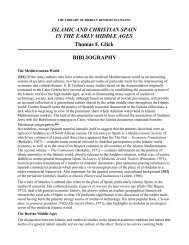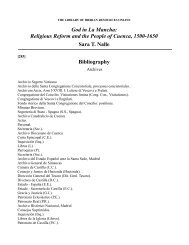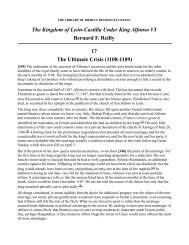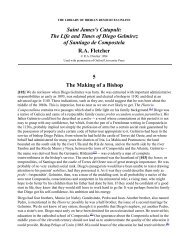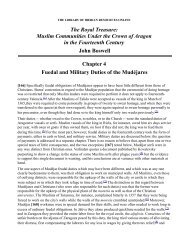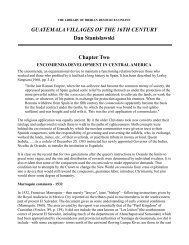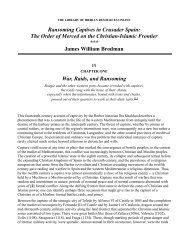The Cluniac Priories of Galicia and Portugal - The Library of Iberian ...
The Cluniac Priories of Galicia and Portugal - The Library of Iberian ...
The Cluniac Priories of Galicia and Portugal - The Library of Iberian ...
You also want an ePaper? Increase the reach of your titles
YUMPU automatically turns print PDFs into web optimized ePapers that Google loves.
priories <strong>and</strong> warning <strong>of</strong>f violators <strong>of</strong> their rights <strong>and</strong> properties. (133) In another diploma issued on 23<br />
March 1169, five days before, the Leonese monarch had extended royal protection to Prior Constantine<br />
<strong>and</strong> the monks <strong>of</strong> San Martín de Jubia against milites et satellites et rustici who were invading the<br />
priory's coto, seizing its l<strong>and</strong>s <strong>and</strong> carrying <strong>of</strong>f into marriage elsewhere women from its aldeas. (134)<br />
Thus all four <strong>of</strong> Cluny's Gallegan houses were under attack <strong>and</strong> in need <strong>of</strong> the king's assistance.<br />
Such threats to stability were not unknown in Leon, as the mention <strong>of</strong> San Salvador de Palaz de Rey<br />
<strong>and</strong> Villafranca in the [344] charter <strong>of</strong> 28 March disclose; but it is in the Rioja that dangers even more<br />
serious than the Gallegan troubles can be found. Here the prior-chamberlain Raymond <strong>of</strong> Nájera had<br />
been engaged for over a decade in a bitter conflict with the see <strong>of</strong> Calahorra, whose bishops had urged<br />
the cardinal-legate Jacinthus during his Spanish tour <strong>of</strong> 1155 to annul Alfonso VI's donation <strong>of</strong> Santa<br />
María to Cluny on the grounds that it was really the Burgundian queen Constance who had connived at<br />
this alienation. (135) Calahorra also challenged the priory's title to the tenth <strong>of</strong> the portazgo <strong>of</strong> Logroño,<br />
granted it in 1149 by Alfonso VII, (136) disputed her possession <strong>of</strong> churches, tithes <strong>and</strong> l<strong>and</strong>s, <strong>and</strong> the<br />
monks' right to perform parochial duties; <strong>and</strong> episcopal agents (according to Raymond) invaded the<br />
monastery, flogged the monks, stole their library, despoiled the altars, <strong>and</strong> caused damage amounting to<br />
over 500 aurei. (137) By 1169 Raymond had personally suffered defeat, for on 31 August Alex<strong>and</strong>er III<br />
ordered him sent back to Cluny as a simoniac for having purchased a forged document declaring him<br />
abbot <strong>of</strong> San Millán de la Cogolla, <strong>and</strong> for having hoodwinked Alfonso VIII into believing that this<br />
incredible fantasy had the approval <strong>of</strong> the monks there as well as <strong>of</strong> Count Lope Diaz <strong>and</strong> the<br />
Calahorran bishop. (138) <strong>The</strong> king banished the unhappy prior-chamberlain from the realm on grounds<br />
<strong>of</strong> simony <strong>and</strong> illegal alienation <strong>of</strong> Nájera's patrimonies ; (139) <strong>and</strong> Santa María was left demoralized <strong>and</strong><br />
pilotless, to be rescued by the labors <strong>of</strong> Humbert <strong>of</strong> Carrión.<br />
For Humbert, occupied down to at least 1171 in restoring stability to the Riojan priory, <strong>and</strong> more<br />
cognizant than any other <strong>Cluniac</strong> <strong>of</strong>ficial <strong>of</strong> the multiple difficulties harassing the abbey's dependencies<br />
elsewhere, the creation <strong>of</strong> another province must have seemed urgent, not primarily because <strong>of</strong><br />
conditions in <strong>Galicia</strong>, but in order to avert the threatened ruin <strong>of</strong> Santa María de Nájera. A second<br />
cameraria would provide the once flourishing priory, with its complex <strong>of</strong> sub-priories, churches <strong>and</strong><br />
domains extending beyond the Rioja into Navarre [345] <strong>and</strong> the Castilian Bureba, with a governing<br />
<strong>of</strong>ficial <strong>of</strong> far greater authority than a mere prior, who would be permanently resident in the house to<br />
guide its course as no intermittently present Carrión chamberlain could do. Furthermore, its<br />
establishment would diminish the danger that the Nájeran chapter, resentful <strong>of</strong> the inevitably austere<br />
measures required for its recovery, <strong>and</strong> mindful <strong>of</strong> Nájera's former position as camerarial seat <strong>of</strong><br />
Hispania, might defy an authority imposed upon it from its rival San Zoil.<br />
But why choose the priories <strong>of</strong> <strong>Galicia</strong> to provide the subordinate dependencies for a Riojan<br />
cameraria? Not certainly out <strong>of</strong> regard for contemporary provincial organization in the secular church,<br />
or the political boundary lines <strong>of</strong> the <strong>Iberian</strong> kingdoms. <strong>The</strong> diocese <strong>of</strong> Calahorra, in which Santa María<br />
lay, faced east as a suffraganate <strong>of</strong> Tarragona; <strong>and</strong> the division does not correspond to the then<br />
separated kingdoms <strong>of</strong> Castile <strong>and</strong> Leon. To be sure, ca. 1170 both <strong>Galicia</strong> <strong>and</strong> the Rioja were areas <strong>of</strong><br />
intense inter-state conflict. From late in Alfonso VII's reign <strong>and</strong> on into that <strong>of</strong> Fern<strong>and</strong>o II -- at least<br />
until the latter's victory at Badajoz in 1169 -- much <strong>of</strong> southern <strong>Galicia</strong>, <strong>and</strong> specifically the Toroño<br />
district with San Salvador de Budiño, was controlled by the armies <strong>of</strong> King Alfonso Henriques <strong>of</strong><br />
<strong>Portugal</strong>. (140) In the same period the Rioja witnessed attempts by Sancho VI <strong>and</strong> Sancho VII <strong>of</strong> Navarre<br />
to annex this fertile region to Pamplona, although by 1179 Alfonso VIII <strong>of</strong> Castile had regained control<br />
<strong>of</strong> most <strong>of</strong> the area. (141) But no <strong>Cluniac</strong> plan to avoid enmeshment in these struggles or to appease<br />
<strong>Portugal</strong> <strong>and</strong> Navarre by placing the priories <strong>of</strong> the contested zones outside the Leonese-Castilian<br />
sphere <strong>of</strong> Hispania can be discerned; this could only have antagonized Fern<strong>and</strong>o II <strong>and</strong> Alfonso VIII,



